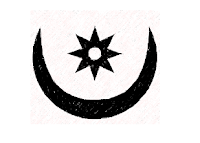 |
| African Adinkra symbols meanings Bi Nka Bi (harmony), Ese Ne Tekrema (interdependence), Denkyem (adaptability), Fihankra (security), Gye Nyame (importance of God) |
Love Never Loses Its Way Home | The Language of African Symbols
West Africa Adinkra symbols represent ideas, proverbs, expressions, attitudes and behavior depicted in simply drawn figure. Adinkra symbols are well-known visual symbols that have a hidden meaning, deciphering Adinkra symbols is the same as reading a sentence as long as you know what is the symbols true meaning.
 |
| Odo Nnyew Fie Kwan |
Odo Nnyew Fie Kwan- secret meaning is “Love never loses its way home" Odo Nnyew Fie Kwan is the symbol for the power of love.
 |
| Akoma Ntoso |
 |
| Osram Ne Nsoromma |
Why wearing Adinkra symbols are popular
Adinkra symbols are popular today as commercial logos and personal tattoos. These symbols have been worn in Africa to express personal theological or philosophical beliefs for centuries.
Tattoos of Adinkra symbols are tricky, can communicate trust or chaos, make you look smart or clueless, and come across as expensive or cheap. Today, social media is the driver, the Adinkra symbols resonating with those selfie addicts who like to flash their heavily tatted trophies on Instagram, their Adinkra symbol readily identifiable.
However, status is not the only draw. Younger people are adopting Adinkra symbols to signal their allegiance to a tribe or cause. Whether we want to admit it or not, we are influenced by, how others look and treat them accordingly.
Is wearing Adinkra symbols cultural appropriation?
The Atlantic 2015 article by Jenni Avins and Quartz stated "Such borrowing is how we got treasures such as New York pizza and Japanese denim—not to mention how the West got democratic discourse, mathematics, and the calendar. Yet as wave upon wave of shrill accusations of cultural appropriation make their way through the Internet outrage cycle, the rhetoric ranges from earnest indignation to patronizing disrespect.
The article goes on further by saying: In the 21st century, cultural appropriation—like globalization—isn’t just inevitable; it’s potentially positive. We have to stop guarding cultures and subcultures in efforts to preserve them. It’s naïve, paternalistic, and counterproductive. Plus, it’s just not how culture or creativity work. The exchange of ideas, styles, and traditions is one of the tenets and joys of a modern, multicultural society.
“It’s not fair to ask any culture to freeze itself in time and live as though they were a museum diorama,” says Susan Scafidi, a lawyer and the author of Who Owns Culture? Appropriation and Authenticity in American Law. Cultural appropriation can sometimes be the savior of a cultural product that has faded away.”
Engage with other cultures on more than an aesthetic level “What would America be like if we loved black people as much as we love black culture?” asks Stenberg . Cherry-picking cultural elements, whether dance moves or print designs, without engaging with their creators or the cultures that gave rise to them not only creates the potential for misappropriation; it also misses an opportunity for art to perpetuate real, world-changing progress.
"The flowers of tomorrows are in the seeds of today." – African Proverb. Love binds us all together in perfect unity.
African Adinkra symbols meanings Bi Nka Bi (harmony), Ese Ne Tekrema (interdependence), Denkyem (adaptability), Fihankra (security), Gye Nyame (importance of God)
Historical African Country Name
Top 20 Largest Countries in Africa
How many countries does Africa have?
Roots of Africanized Christianity Spiritual Songs
Chocolate Processing Facts History and Recipes
Awesome Kenyan Woman
Land is Not For Women in Sierra Leone
African Kente Cloth Facts
Accra the Ghanaian Capital Ultimate Mall Experience





























